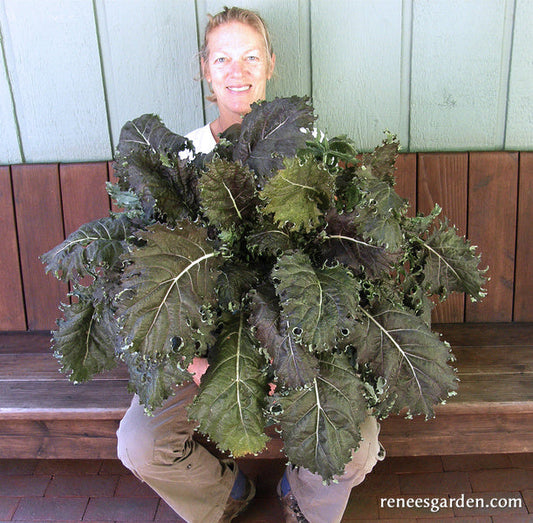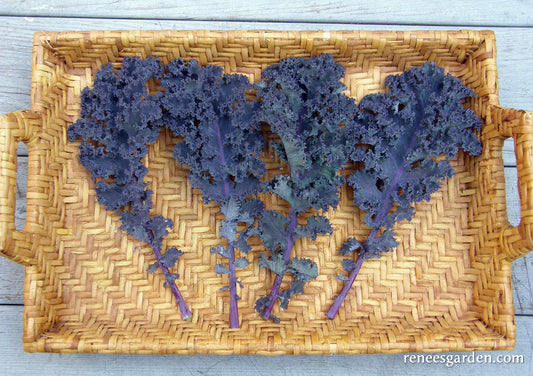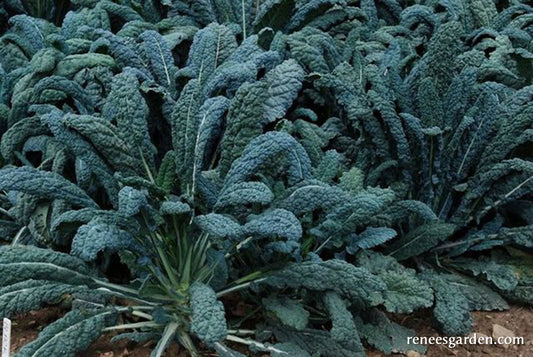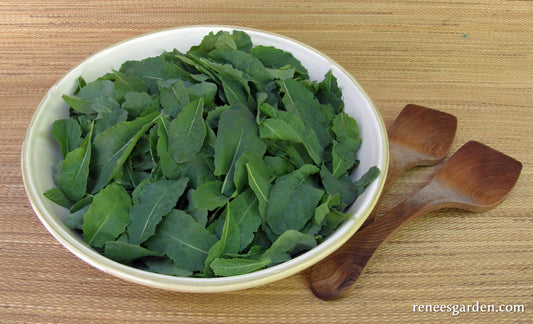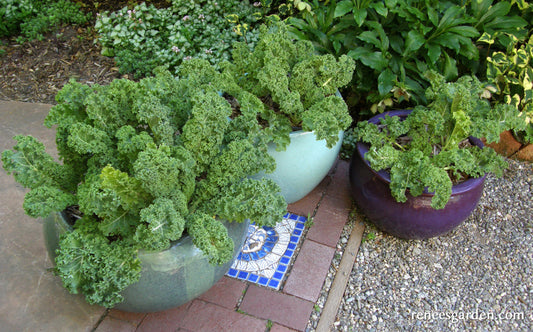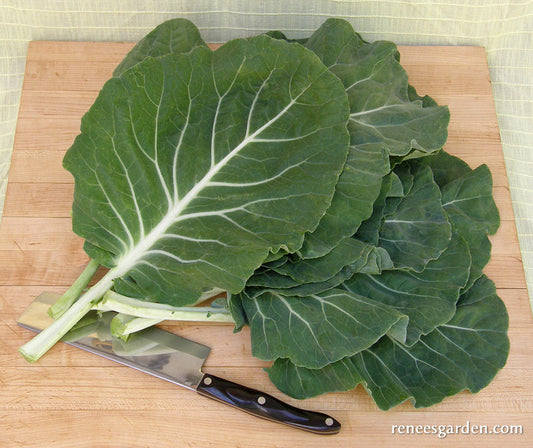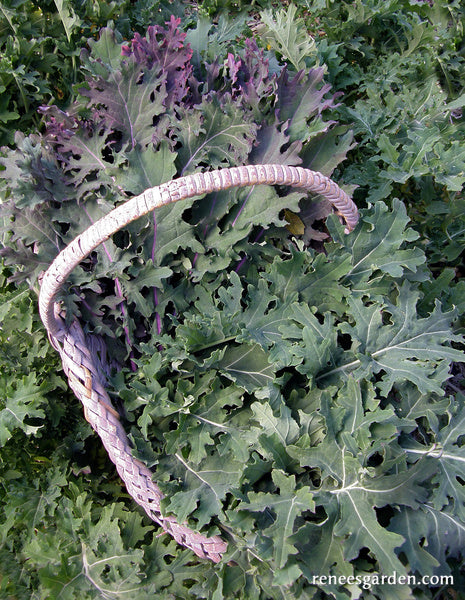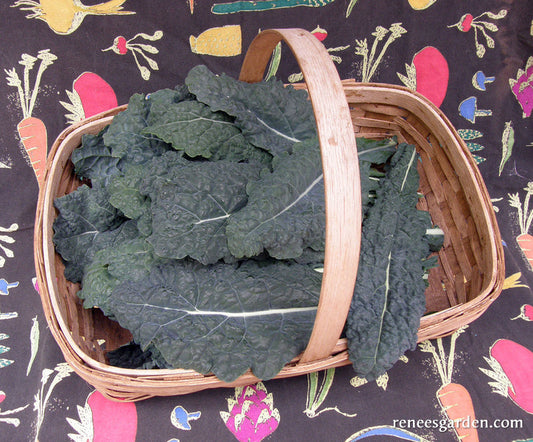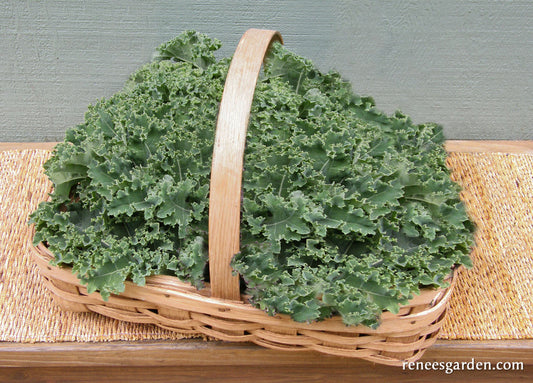Kale
-
Specialty Kale Mars Landing
TO START DIRECTLY IN THE GARDEN
As soon as ground can be worked in spring, prepare a well-drained, fertile garden bed in full sun. Sow groups of 3 seeds each 10-12 inches apart and 1/2 inch deep, in rows 12-18 inches apart. Keep soil evenly moist. When seedlings are 3 inches tall, thin to just 1 seedling per group. Sow again in late summer for another cold-hardy crop.
TO START INDOORS
Sow seeds in a container of seed starting mix 2 inches apart and cover 1/2 inch deep. Keep moist and provide a strong light source until seedlings are 3 to 4 inches tall then plant outdoors.
THIN OR TRANSPLANT
Space 10 to 12 inches apart so plants have room to mature.
GROWING NOTES
Kale tastes best in cool weather so sow spring crops early. A late summer-sown crop will yield through fall and winter except in the coldest climates. Frost actually enhances kale leaves’ color, flavor and sweetness. Mulch to retain moisture in summer and before the ground freezes to protect the roots of fall crops.
HARVEST AND USE
Begin harvesting outer leaves when plants have 6 to 8 leaves. Vitamin-rich kale is delicious in hearty winter soups, stews and sautés; or braise the beautiful leaves with garlic and olive oil in traditional Mediterranean style. Pull and discard once plants begin to bloom since the leaves of flowering stalks get tough and bitter.
Regular price $3.69Sale price $3.69Unit price / per -
Gourmet Kale Purple Moon
TO START DIRECTLY IN THE GARDEN
As soon as ground can be worked in spring, plant in well-drained, fertile garden soil in full sun. Sow groups of 3 seeds each 10-12 inches apart and 1/2 inch deep, in rows 12-18 inches apart. Keep soil evenly moist. When seedlings are 3 inches tall, thin to just 1 seedling per group. Sow again in late summer.
TO START INDOORS
Sow seeds 2 in. apart and 1/2 in. deep in a container of seed starting mix. Keep moist and provide a strong light source until seedlings reach 3 to 4 in. tall, then plant outdoors 10 to 12 in. apart.
GROWING NOTES
Kale tastes best in cool weather, so sow spring crops early. A late summer-sown crop will yield through fall and winter except in the coldest climates. Frost actually enhances kale leaf color, flavor and sweetness. Mulch to retain moisture in summer and before the ground freezes to protect the roots of fall crops.
HARVEST AND USE
Begin harvesting outer leaves when plants have 6 to 8 leaves. Vitamin-rich kale is delicious with stems removed and leaves cut in very thin strips for fresh salads with nuts and fruit. Braise with garlic and olive oil in traditional Mediterranean style. Enjoy in hearty winter soups, stews and sautés. Pull and discard once plants begin to bloom as flowering plants get tough and bitter.
Regular price $4.89Sale price $4.89Unit price / per -
Heirloom Kale Lacinato "Dinosaur"
TO START SEEDS DIRECTLY IN THE GARDEN
As soon as ground can be worked in spring, plant in well-drained, fertile garden soil in full sun. Sow seeds 2 in. apart in rows 12 in. apart. Cover 1/2 inch deep. Keep soil evenly moist. When seedlings are 3 in. tall, thin to 10-12 in. apart. Sow again in late summer.
TO START INDOORS
Sow seeds 2 in. apart and 1/2 in. deep in a container of seed starting mix. Keep moist and provide a strong light source until seedlings reach 3 to 4 in. tall, then plant outdoors 10 to 12 in. apart.
GROWING NOTES
Kale tastes best in cool weather, so sow spring crops early. A late summer-sown crop will yield through fall and winter except in the coldest climates. Frost actually enhances kale leaf color, flavor and sweetness. Mulch to retain moisture in summer and before the ground freezes to protect the roots of fall crops.
HARVEST AND USE
Begin harvesting outer leaves when plants have 6 to 8 leaves. Vitamin-rich kale is delicious with stems removed and leaves cut in very thin strips for fresh salads with nuts and fruit. Braise with garlic and olive oil in traditional Mediterranean style. Enjoy in hearty winter soups, stews and sautés. Pull and discard once plants begin to bloom as flowering plants get tough and bitter.
Regular price $4.89Sale price $4.89Unit price / per -
Heirloom Italian Kale Tuscan Baby Leaf
BEST TO START DIRECTLY OUTDOORS
Beginning in early spring, sow seeds in finely worked soil in full sun. Shake seeds loosely from your hand, broadcasting about 1 inch apart over the entire seedbed or in wide rows, and cover lightly and evenly with 1/4 inch of fine soil. Firm soil gently and water in with a fine spray, then keep seedbed evenly moist. Make successive sowings every 3 weeks until summer weather turns really hot for a constant supply. Plant again in late summer for fall harvesting.
GROWING NOTES
For best flavor, kale needs consistent moisture and mild weather conditions. Birds love tender young kale seedlings, so protect them as necessary with netting or floating row covers. This attractive edible will also grow well in pots at least 18 to 20 inches across to snip as needed for salads or stir-fry.
HARVEST AND USE
To harvest by the “cut and come again” method: when plants are 4 to 5 inches tall, cut as much as you need, by using scissors to shear off leaves 1 to 2 inches above the soil level. Water well and fertilize lightly and plants will regrow for several more cuttings. These tasty and highly nutritious leaves are delicious used as fresh salads, especially with a handful of chopped nuts and fruit like apples or pears. Or stir-fry very quickly for healthy quick greens.
Regular price $4.39Sale price $4.39Unit price / per -
Container Kale Green Curls
TO START INDOORS
In very early spring, sow seeds in seed starting mix 2 in. apart and 1/2 in. deep. Keep moist and provide a strong light source until seedlings are well-established, then plant outdoors 6 in. apart.
PLANTING IN CONTAINERS
Use pots a minimum of 15-18 in. in diameter and 12 in. deep and start with fresh potting mix. Sow groups of 2-3 seeds 6 in. apart, 1/2 in. deep. Keep evenly moist. When large enough to handle, thin to leave one seedling per group, so plants have room to mature. Keep mulched to conserve moisture. Feed with high nitrogen fertilizer every 2-3 weeks. If it gets hot, check and water daily; otherwise, water when top inch of soil is dry.
GROWING NOTES
Kale tastes best in cool weather and frost actually enhances color, flavor and sweetness. Plant in early spring and again in late summer/early fall.
HARVEST AND USE
Begin harvesting outer leaves when plants have at least 6 leaves. Vitamin and antioxidant rich kale is tender and delicious in fresh salads, especially with sliced fruit and/or nuts. Use in smoothies, soups, stews and sautés; or braise with garlic and olive oil. Pull and discard when plants begin to bloom as leaves of flowering stalks get tough and bitter.
Regular price $3.99Sale price $3.99Unit price / per -
Portuguese Kale Tronchuda Beira
TO START DIRECTLY IN THE GARDEN
As soon as ground can be worked in spring, prepare a well-drained, fertile garden bed in full sun. Sow groups of 2 to 3 seeds, each group 12 to 18 inches apart. Cover 1/4 deep and keep soil evenly moist to ensure good germination. Thin to one seedling per group when several inches tall. Sow again in mid to late summer for another cold-hardy crop.
TO START INDOORS
Sow seeds in a container of seed starting mix 2 inches apart and cover 1/4 inch deep. Keep moist and provide a strong light source until seedlings are 3 to 4 inches tall, then plant outdoors. Space 12 to 18 inches apart.
GROWING NOTES
Kale can be sown in spring as early as the ground can be worked. A second mid to late summer-sown crop will yield through fall and winter except in the coldest climates. Frost actually enhances kale leaves’ color, flavor and sweetness. Mulch to retain moisture in summer and before the ground freezes to protect the roots of fall crops.
HARVEST AND USE
Begin harvesting large individual outer leaves when plants have 6 to 8 big leaves. Enjoy sautéed, stirfried, braised or added to soups and stews. Portuguese kale pairs well with olive oil, garlic and lemon juice (reneesgarden.com/portuguese-kale-soup). Pull and discard once plants begin to bloom as the leaves of flowering stalks get tough and bitter.
Regular price $3.99Sale price $3.99Unit price / per -
Heirloom Russian Kale Wild Garden Frills
TO START DIRECTLY IN THE GARDEN
As soon as ground can be worked in spring, prepare a well-drained, fertile garden bed in full sun. Sow seeds 2 inches apart in rows 12 to 18 inches apart. Cover 1/2 inch deep and keep soil evenly moist to ensure good germination. Sow again in late summer for another cold-hardy crop.
TO START INDOORS
Sow seeds in a container of seed starting mix 2 inches apart and cover 1/2 inch deep. Keep moist and provide a strong light source until seedlings are 3 to 4 inches tall then plant outdoors. Space 10 to 12 inches apart so plants have room to mature.
GROWING NOTES
Kale tastes best in cool weather so sow spring crops early. If sown in late summer, kale will yield through fall and winter except in the coldest climates. Frost actually enhances kale leaves’ color, flavor and sweetness. Mulch to retain moisture in summer and before the ground freezes to protect the roots of fall crops.
HARVEST AND USE
Begin harvesting outer leaves when plants have 6 to 8 leaves. Vitamin-rich kale is delicious in hearty winter soups, stews and sautés; or braise the beautiful leaves with garlic and olive oil in traditional Mediterranean style. Pull and discard once plants begin to bloom since the leaves of flowering stalks get tough and bitter.
Regular price $4.89Sale price $4.89Unit price / per -
Italian Heirloom Kale Lacinato
TO START DIRECTLY IN THE GARDEN
As soon as ground can be worked in spring, prepare a well-drained, fertile garden bed in full sun. Sow seeds 2 inches apart in rows 12 to 18 inches apart. Cover 1/2 inch deep and keep soil evenly moist to ensure good germination. Sow again in late summer for another cold-hardy crop.
TO START INDOORS
Sow seeds in a container of seed starting mix 2 inches apart and cover 1/2 inch deep. Keep moist and provide a strong light source until seedlings are 3 to 4 inches tall then plant outdoors. Space 10 to 12 inches apart so plants have room to mature.
GROWING NOTES
Kale tastes best in cool weather so sow spring crops early. A late summer-sown crop will yield through fall and winter except in the coldest climates. Frost actually enhances kale leaves’ color, flavor and sweetness. Mulch to retain moisture in summer and before the ground freezes to protect the roots of fall crops.
HARVEST AND USE
Begin harvesting outer leaves when plants have 6 to 8 leaves. Vitamin-rich kale is delicious in hearty winter soups, stews and sautés; or braise the beautiful leaves with garlic and olive oil in traditional Mediterranean style. Pull and discard once plants begin to bloom since the leaves of flowering stalks get tough and bitter.
Regular price $2.99Sale price $2.99Unit price / per -
Triple-Curled Kale Dutch Darkibor
TO START DIRECTLY IN THE GARDEN
As soon as ground can be worked in spring, prepare a well-drained, fertile garden bed in full sun. Sow seeds 2 inches apart in rows 12 to 18 inches apart. Cover 1/2 inch deep and keep soil evenly moist to ensure good germination. Sow again in late summer for another cold-hardy crop.
TO START INDOORS
Sow seeds in a container of seed starting mix 2 inches apart and cover 1/2 inch deep. Keep moist and provide a strong light source until seedlings are 3 to 4 inches tall then plant outdoors. Space 10 to 12 inches apart so plants have room to mature.
GROWING NOTES
Kale tastes best in cool weather so sow spring crops early. A crop sown in late summer will yield through fall and winter except in the coldest climates. Frost actually enhances kale leaves’ color, flavor and sweetness. Mulch to retain moisture in summer and before the ground freezes to protect the roots of fall crops.
HARVEST AND USE
Begin harvesting outer leaves when plants have 6 to 8 leaves. Vitamin-rich kale is delicious in hearty winter soups, stews and sautés; or braise the beautiful leaves with garlic and olive oil in traditional Mediterranean style. Pull and discard once plants begin to bloom since the leaves of flowering stalks get tough and bitter.
Regular price $3.99Sale price $3.99Unit price / per

